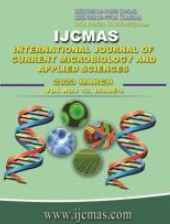


 National Academy of Agricultural Sciences (NAAS)
National Academy of Agricultural Sciences (NAAS)

|
PRINT ISSN : 2319-7692
Online ISSN : 2319-7706 Issues : 12 per year Publisher : Excellent Publishers Email : editorijcmas@gmail.com / submit@ijcmas.com Editor-in-chief: Dr.M.Prakash Index Copernicus ICV 2018: 95.39 NAAS RATING 2020: 5.38 |
The study of heavy metal resistant bacteria isolated from polluted site is of interest, as this may provide new isolates and probably new genetic information on heavy metal resistance which could be explored for bioremediation purpose. The aim of this study was to assay for resistance by plasmid-cured Bacillus species from polluted soil of a cement factory. Heavy metals used were cadmium, cobalt and zinc. Various biochemical characterizations such as spore staining, gelatin liquefaction, casein liquefaction, starch hydrolysis, hydrogen sulphide production, indole, motility, gas production, voges proskauer, citrate, and various sugar fermentation were carried out on bacterial isolates. Plasmid curing was carried out on bacterial isolates (n=19) using ethidium bromide. Cured bacteria were assayed for resistance to heavy metals such as cadmium (Cd), cobalt (Co) and zinc (Zn) by inoculation on nutrient agar supplemented with salts of various heavy metals at different concentrations (mg/mL). Bacterial isolates were identified as Bacillus tequilensis, Bacillus weidmannii, Bacillus subtilis, Bacillus toyonensis, Bacillus safensis and Bacillus cereus. The UV transilluminator image of the plasmids gel electrophoresis showed that Bacillus species were indeed plasmid-cured in that they lost their plasmids. Plasmid curing resulted in loss of heavy metal resistance in some isolates, while some of the plasmid-cured derivatives demonstrated resistance to these heavy metals. The finding of this study showed that heavy metal resistance is both mediated by genetic markers borne on plasmid and chromosomal DNA in these Bacillus species.
 |
 |
 |
 |
 |